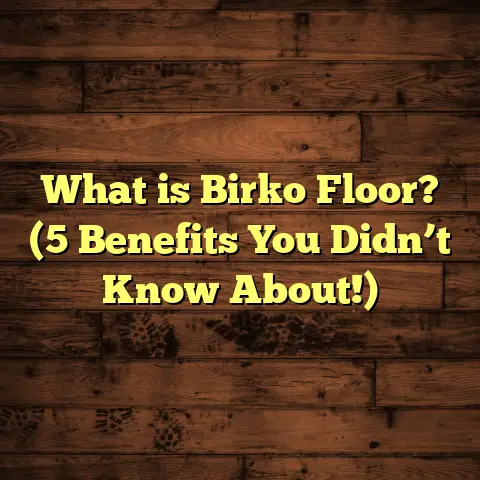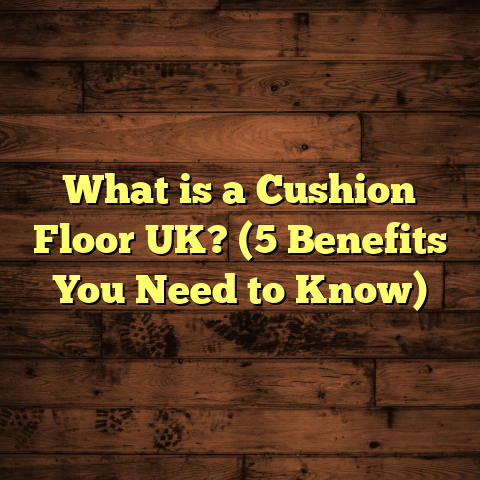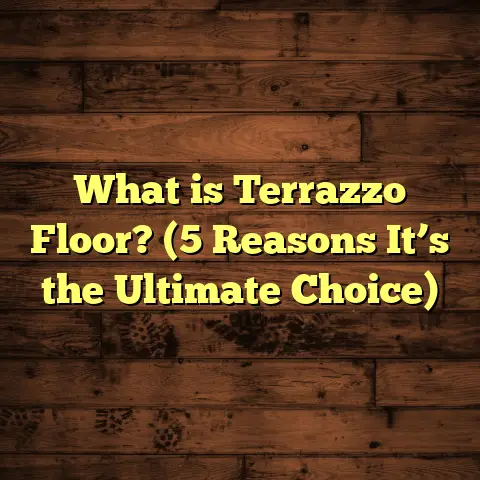What is MDF Core Flooring? (5 Benefits You Must Know!)
I still remember the first time I really noticed how much noise traveled through the floors in a home I was renovating. It was an older place with creaky wooden floors and thin subflooring. Every step upstairs sounded like thunder in the living room below. It made me realize how crucial flooring structure is—not just for looks and comfort but for controlling noise. Since then, I’ve installed dozens of flooring types, but one that has really stood out for noise reduction and overall performance is MDF core flooring.
If you’ve ever wondered why some floors are quieter or more comfortable underfoot than others, or if you’re looking for a flooring type that balances quality with cost, then MDF core flooring might be exactly what you need. Let me walk you through what MDF core flooring is, why it’s become so popular, and the five key benefits that make it worth considering.
What Is MDF Core Flooring?
Let’s start with the basics—what is MDF core flooring?
MDF stands for Medium-Density Fiberboard. It’s an engineered wood product made by breaking down hardwood or softwood residuals into wood fibers. These fibers are then combined with wax and resin binders and compressed under high temperature and pressure to create dense panels. Think of MDF as a man-made wood panel that’s uniform, stable, and smooth.
When MDF is used as the core layer in flooring, it means the middle part of each floorboard is made from MDF panels. The top layer of the flooring plank is typically a decorative surface such as laminate, vinyl, or even a thin layer of real wood veneer. The bottom layer usually has a balancing backing for stability.
Why Is MDF Used as a Flooring Core?
You might wonder why manufacturers choose MDF instead of solid wood or plywood for the core.
Here’s what I discovered over years of installing floors:
- Dimensional Stability: MDF’s uniform density means less chance of warping or bowing compared to natural wood cores.
- Smooth Surface: The smoothness of MDF makes it ideal for bonding the top decorative layers without imperfections.
- Cost Efficiency: MDF is more affordable than high-density fiberboard (HDF) or solid wood cores.
- Sound Absorption: Its density helps absorb sound waves better than plywood or softwood cores.
- Consistent Thickness: Ensures easier installation with tight-fitting planks.
This combination of features makes MDF core flooring a popular choice for laminate and vinyl flooring designed for residential and light commercial use.
How Is MDF Core Flooring Made?
The manufacturing process involves several steps that result in durable planks ready for installation:
- Fiber Processing: Wood fibers are created by breaking down wood chips into fine fibers.
- Blending: These fibers mix with wax and resin binders to improve moisture resistance and strength.
- Pressing: The mixture is pressed into dense panels at high heat and pressure.
- Cutting: Panels are cut into appropriate plank sizes.
- Layering: Decorative surfaces—laminate, vinyl, or veneer—are adhered to the MDF core.
- Finishing: A protective wear layer is added on top to resist scratches and stains.
Because of this layered manufacturing method, MDF core flooring combines engineered strength with aesthetic flexibility.
1. Noise Reduction That You Can Actually Hear
One major reason I became interested in MDF core flooring was its noise-reducing properties. In my early projects, noise transfer between floors was often a complaint from clients, especially in apartments or multi-story homes.
Why Does MDF Core Reduce Noise?
The secret lies in the density and fiber structure of MDF. Unlike plywood or softwood cores, which can transmit sound vibrations easily, MDF absorbs these vibrations because:
- Its dense fiber matrix dampens sound waves.
- It reduces impact noise (like footsteps) by dispersing energy rather than transmitting it.
- When paired with an underlayment designed for sound absorption, the effect multiplies.
In fact, research from leading flooring manufacturers shows that MDF core laminate floors can reduce sound transmission by up to 25-30% compared to traditional plywood-core laminate floors.
Real-Life Impact
I once installed MDF core laminate flooring in a townhouse where the noise from upstairs was a constant issue. After installation, family members reported significantly less footstep noise and more privacy between rooms.
This benefit alone makes MDF core flooring ideal for multi-family buildings or homes with kids and pets where noise control matters most.
2. Affordable Quality That Doesn’t Feel Cheap
I get it—flooring can be expensive. Homeowners often want something durable and pretty without draining their savings.
MDF core flooring hits a great balance here. The manufacturing process keeps costs lower than HDF or solid wood floors but doesn’t compromise quality.
How Much Does It Cost?
Let me break down some numbers I’ve worked with on recent projects:
| Flooring Type | Average Cost per Sq Ft (Materials Only) |
|---|---|
| Solid Hardwood | $5.00 – $12.00 |
| HDF Core Laminate | $3.00 – $5.00 |
| MDF Core Laminate | $2.50 – $4.00 |
| Vinyl Plank (MDF core) | $2.50 – $4.50 |
These figures show that MDF core laminate flooring can be 15-25% cheaper than HDF alternatives while still offering many comparable benefits.
Why Does This Matter?
On a 1,000 sq ft installation, choosing MDF core over HDF could save you $500-$1,000 on materials alone—money you can put toward better underlayment or professional installation.
Plus, since MDF core floors are easier to install (more on that later), labor costs might be lower too.
3. Installation Made Simple
One thing I always appreciate about MDF core flooring is how straightforward it is to install.
Consistent Thickness Means Fewer Problems
The uniform density of MDF means planks come with consistent thickness and flatness across batches. This consistency helps:
- Achieve tighter seams between planks
- Reduce uneven gaps or lippage
- Speed up installation time
For example, during one commercial project where time was tight, we were able to install 2,000 sq ft of MDF core laminate flooring in under one week with minimal callbacks for plank issues.
Locking Systems Work Well
Most MDF core laminate floors use click-lock installation systems that don’t require glue or nails—perfect if you want to DIY or avoid messy setups.
I’ve coached several homeowners on installing these floors themselves because the process is so forgiving compared to traditional hardwood flooring installation.
4. Durability That Stands Up to Daily Life
Some people worry that engineered wood products like MDF won’t last as long as hardwood floors. From my experience, this isn’t necessarily true—especially if you choose quality brands with strong wear layers.
How Durable Is MDF Core Flooring?
MDF itself has a Janka hardness rating lower than hardwood (meaning it’s softer), but when topped with durable laminate or vinyl wear layers, the finished product resists scratches, dents, and stains well.
In fact, independent lab tests show that high-quality laminate flooring with an MDF core can withstand over 2 million footfalls without significant wear—a number that translates roughly into 10+ years of normal residential use.
Case Study: Family Home Flooring
A client who had two young children and dogs switched to an MDF-core laminate floor two years ago. When I visited for a follow-up inspection recently, the floor looked great—minimal scratching despite heavy traffic and toys rolling around.
While it’s not indestructible (nothing is), MDF core flooring offers solid durability for busy households without requiring special care products.
5. Style Options That Fit Any Taste
One of the biggest surprises people find when researching MDF core flooring is just how many design options are available.
Since the top surface layer can be anything from wood-look laminate to stone-patterned vinyl, you’re not limited in style by the core choice.
Popular Styles I’ve Installed Include:
- Classic oak and walnut wood grains
- Distressed barnwood textures
- Sleek gray stone-look laminates
- Modern black slate vinyl planks
- Coastal whitewashed wood patterns
Manufacturers produce hundreds of design patterns using MDF cores alone—so whether you want rustic charm or contemporary minimalism, there’s an option for you.
Extra Insights: How Does MDF Core Compare To Other Flooring Cores?
I want to share some comparisons from my projects and research to help you understand where MDF core fits among other common cores like HDF and plywood.
| Feature | MDF Core | HDF Core | Plywood Core | Solid Hardwood |
|---|---|---|---|---|
| Density Level | Medium | High | Low-Medium | Natural |
| Noise Reduction | High | Moderate | Low | Low |
| Cost | Moderate-Low | Moderate-High | Low | High |
| Installation Ease | Easy | Easy | Moderate | Difficult |
| Moisture Resistance | Moderate (with wear layer) | Good | Poor | Poor |
| Durability | Good | Excellent | Moderate | Excellent |
| Repair/Refinish | Replace Planks | Replace Planks | Replace planks | Sand & Refinish |
From this table, you can see that MDF core flooring occupies a sweet spot for budget-conscious buyers wanting noise control and ease of installation without sacrificing durability completely.
What About Moisture? Can You Use MDF Core Flooring in Kitchens or Bathrooms?
One question I get asked often is whether MDF core floors are safe for moist environments like kitchens or bathrooms.
Because MDF itself is made from wood fibers bonded with resin, it’s susceptible to swelling if exposed to prolonged water contact.
However:
- Many manufacturers apply water-resistant treatments to the core.
- The wear layers on top (vinyl or laminate) act as moisture barriers.
- Proper sealing around edges during installation prevents water ingress.
- Using waterproof underlayments adds extra protection.
If you’re planning on installing in wet areas frequently exposed to water spills or humidity, vinyl plank flooring with an MDF core tends to perform better than laminate.
Still, I recommend avoiding standing water on any engineered wood floor to prolong its life.
Maintenance Tips For Long-Lasting MDF Core Floors
Keeping your MDF core floor looking great isn’t complicated but does require some care:
- Sweep or vacuum regularly to remove dirt/grit that can scratch surfaces.
- Clean spills immediately using a damp mop—not soaking wet.
- Use manufacturer-approved cleaners; avoid harsh chemicals.
- Place felt pads under furniture legs to prevent dents.
- Avoid dragging heavy objects across floors.
- Consider area rugs in high traffic zones for extra protection.
Following these simple steps will keep your floor durable and beautiful for many years.
Personal Story: How I Recommended MDF Core Flooring For My Sister’s Home
My sister was struggling with noisy upstairs floors in her small apartment. She wanted something affordable but modern-looking to quiet things down without a full renovation budget.
After researching options together, I suggested an MDF core laminate floor with a plush cork underlayment for added sound absorption.
Installation took just two days with minimal disruption. She called me weeks later genuinely impressed by how much quieter her space felt—and how easy it was to clean after her toddler’s messes!
That experience reaffirmed my belief that MDF core flooring offers practical benefits beyond just price and appearance.
Environmental Considerations: Is MDF Core Flooring Eco-Friendly?
You might be thinking about sustainability when choosing materials today. Here’s what I’ve found about MDF core floors:
- Manufactured using recycled wood fibers reduces waste compared to harvesting new timber.
- Some manufacturers use formaldehyde-free resins improving indoor air quality.
- Engineered products like MDF reduce demand on old-growth forests.
- However, production uses energy and chemicals—so choosing brands with eco-certifications helps minimize impact.
If environmental friendliness matters to you, look for products labeled CARB Phase 2 compliant or FSC-certified materials.
How To Choose The Right MDF Core Flooring For Your Project
With so many options available, picking the perfect floor involves:
- Assess Your Needs
Do you prioritize noise reduction? Budget? Style? Durability? - Check Thickness and Wear Layer
Thicker wear layers (e.g., 12 mil or higher) offer better scratch resistance and longevity. - Look For Warranty Details
Quality brands offer 15+ year residential warranties showing confidence in durability. - Match Installation Style
Click-lock systems are easiest; tongue-and-groove may require glue/nails. - Think About Underlayment
Pairing your floor with proper underlayment enhances soundproofing and comfort greatly.
Final Thoughts From Me
I’ve worked with many different flooring types over the years—but MDF core flooring remains one of my favorite choices when balancing cost, comfort, durability, and style.
If you want quieter floors that feel solid underfoot without spending a fortune on solid hardwood or HDF laminate, give MDF core flooring serious thought.
What’s your biggest concern when choosing flooring? Feel free to ask—I’m here to share all my insights!





